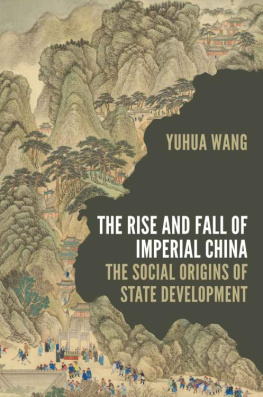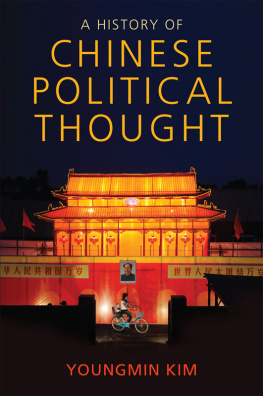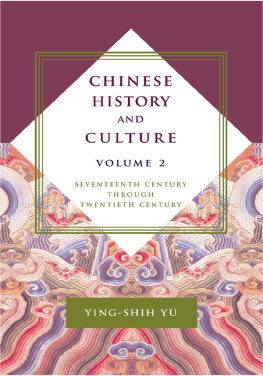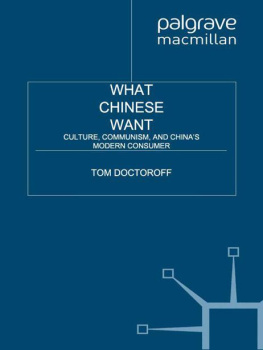CHINA
A New Cultural History
Masters of Chinese Studies
CHINA
A New Cultural History
CHO-YUN HSU
Translated by Timothy D. Baker, Jr. and Michael S. Duke

COLUMBIA UNIVERSITY PRESS
NEW YORK
Columbia University Press wishes to express its appreciation for assistance given by the Chiang Ching-kuo Foundation for International Scholarly Exchange and Council for Cultural Affairs in the publication of this book.
Columbia University Press
Publishers Since 1893
New York Chichester, West Sussex
cup.columbia.edu
Originally published as Wangu jiangshan: Zhongguo lishi wenhua de zhuanzhe yu kaizhan,
Taipei: Yingwen Hansheng, 2006.
Written by Hsu Cho-yun 2006
Illustrations by ECHO Publishing Co., Taipei 2006
English-language edition published by arrangement with ECHO Publishing Co., Ltd., Taipei
Translation copyright 2012 Columbia University Press
All rights reserved
E-ISBN 978-0-231-52818-4
Library of Congress Cataloging-in-Publication Data
Xu, Zhuoyun, 1930
[Wan gu jiang he. English.]
China : a new cultural history / Cho-yun Hsu ; translated by Timothy D. Baker, Jr. and Michael S. Duke.
p. cm. (Masters of Chinese Studies)
Includes bibliographical references and index.
ISBN 978-0-231-15920-3 (cloth : alk. paper) ISBN 978-0-231-15921-0 (pbk.)
ISBN 978-0-231-52818-4 (electronic)
1. ChinaCivilization. 2. ChinaRelations. 3. ChinaSocial life and customs. I. Title. II. Title: Cultural history of China. III. Series.
DS721.X8813 2012
951dc23
2011024504

A Columbia University Press E-book.
CUP would be pleased to hear about your reading experience with this e-book at .
Cover image: National Palace Museum, Taiwan, Republic of China.
References to Internet Web sites (URLs) were accurate at the time of writing. Neither the author nor Columbia University Press is responsible for URLs that may have expired or changed since the manuscript was prepared.
Contents
100004000 B.C.E.
Neolithic cultures appear in various regions of Eastern Asia.
Agriculture develops in both the north and the south.
40002000 B.C.E.
Regional cultures interact with one another.
Cultures in the Yellow River and Yangzi River basins become dominant.
Urbanization and agriculture develop.
20001000 B.C.E.
The Three Dynasties begin with the legendary Xia dynasty.
The Shang kingdom (ca. seventeenth centuryeleventh century B.C.E. ) demonstrates state formation and hegemony.
The Kingdom of Western Zhou (ca. eleventh century771 B.C.E. ) expands its territory under decentralized control.
Bronze cultures flourish.
1000 300 B.C.E.
The collapse of the Zhou kingdom leads to multistate competition.
The Central Plain and Yangzi Valley cultures become clearly defined.
The Hua-Xia cultural identity emerges.
Confucius and Confucianism develop.
Daoism appears as a challenger and alternative to Confucianism.
States evolve toward independent monarchies and bureaucracy.
Urbanization and greatly increased social mobility occur.
Advancements occur in agriculture and technology.
300 B.C.E. 300 C.E.
Qin unification of China (221206 B.C.E.).
Western Han (202 B.C.E. 8 C.E.) and Eastern Han (25220 C.E.) dynasties.
The claim of a Tianxia universal empire supports imperial authority and bureaucracy.
The heritage of intensive farming and marketing networks provides an economic base.
Conflicts arise with a powerful and mobile Xiongnu empire on steppe land in the north.
China is connected with Eurasia by overland trade along the Silk Routes.
China expands its territory to the south and southwest.
Confucian scholars dominate the state bureaucracy.
The New Text movement is counterbalanced by the canonization of Confucian texts.
Buddhism enters China along the trade routes.
An indigenous Chinese response referred to as religious Daoism develops.
Massive peasant uprisings associated with Daoist sects take place.
The Han empire collapses.
The Three Kingdoms period (220280 C.E.) is marked by continual interstate conflict.
300600
Massive invasions of peoples from northern areas penetrate China.
The Western Jin dynasty (265316).
Tribal states are established in the Central Plain and northern areas.
Northern States (420581) include the Northern Wei, Northern Qi, and Northern Zhou dynasties.
Courts are established for the Eastern Jin (317420) and southern states (420589).
Xianbei (Srbi) and other northern peoples merge with the Chinese.
Chinese migrants settling in the south incorporate the indigenous cultures.
Buddhism is well accepted by all levels of society; Daoism develops further in response.
Marine trade increases along with overland trade routes, supporting cultural interactions beyond China.
6001000
Political and cultural reunification of China under the Sui (581618) and Tang (618907) dynasties.
China becomes a transregional power in the inner Asian and Asian-Pacific regions.
Chinese cultural influences spread to Japan and Korea.
Buddhism flourishes in China.
Rivalry develops with newly expanded Islamic powers to the west.
The An Lushan Rebellion destabilizes imperial power.
China is torn by a long period of civil wars.
North China and South China become culturally differentiated.
Extended turmoil due to civil wars, referred to as the Five Dynasties (907960).
10001400
There is rapid rise and fall of dynasties: the Northern Song (9601127), Liao (Khitan; 9161125), Jin (Jurchen; 11251234), Yuan (Mongol; 12711368), West Xia (Tangut; 10381227), and Southern Song (11271276).
Song China is a member of an East Asian multistate community.
North China is ruled by conquest regimes from the north.
There is economic progress, technological advancement, and massive urbanization, along with refinement in the arts and literature.
The Cheng-Zhu School of Confucianism becomes the dominant Confucian orthodoxy.
Mongol expansion leads to conquest and the Yuan dynasty (12711368)
1400 1650
The Ming dynasty (13681644).
China proper regains independence from the Mongol conquest.
China withdraws from Inner Asia.
Asian-Pacific trade dominates foreign trade.
Cross-ocean trade routes are opened by European marine powers, to Chinas benefit.
China enters a new worldwide economic network with the influx of South American silver.
The urbanized South flourishes, and the North becomes impoverished.
Wang Yangmings school of liberal Confucianism arises.
Western culture enters China, including the use of firearms.
Liberalism in the late Ming surges before it is ended by massive peasant uprisings.
16501910
The Qing (Manchu) dynasty (16361911).
Mongolia, Tibet, and todays Xinjiang Province are incorporated into the Manchu empire.
Taiwan enters Chinese history as a Ming loyalist base and supports a community of Chinese migrants.
The Manchu empire is governed by a dual Manchu-Han administration.
Confucian scholarship becomes more conservative.
The population increases after the introduction of new crops from the Americas.
China continues to enjoy substantial economic benefit from foreign trade until imported opium creates a deficit.
China closes itself to Western culture in the eighteenth century.
The Opium War (18391842) leads to encroachment by Western powers.
Next page






